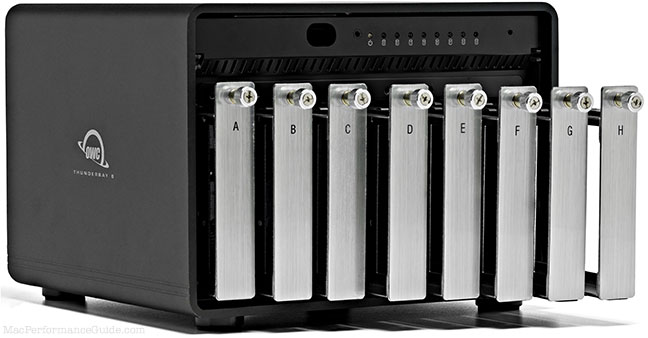
$220 SAVE $130 = 37.0% Western Digital 16.0TB Western Digital Ultrastar DC HC550 3.5-in… in Storage: Hard Drives
|

|

|

|

|
Mercedes Sprinter: Installing a Higher Capacity Fuel Tank (ACGB Tanks)
Related: diesel fuel, Lloyd Chambers, Mercedes Sprinter

Photographer and cyclist and Mac expert and software engineer Lloyd Chambers is available for consulting on general Sprinter considerations at his usual consulting rates via phone, or in person in the Palo Alto, CA area. Save yourself months of planning and costly mistakes by discussing issues up-front. More about Lloyd....
...
Update 28 June 2018: I am delighted with the fuel tank. It is saving me money, and just as important, it has increased the range so that I can go places and never worry about fuel.
Update 15 Jan 2019: before ordering this larger tank, if your Sprinter has RV mods, make sure that there isn’t a water tank or propane tank in a place that would block installing it.
...
Fuel cans and the like in my view are a problematic solution: unless kept outside, they emit a stink. Plus they are a hassle to fill and cycle through the fuel periodically, require external mounting, etc. Junk cluttering up your Sprinter in space better used for gear.
The only elegant solution to having more fuel is a larger fuel tank. Not a dual fuel tank with a pump system, but a larger fuel tank.
How does it make sense to carry 2 or 5 gallons extra fuel in fuel cans when it can be 21 gallons or even 26 gallons more fuel?
A larger fuel tank increases the odds of refueling at the lowest possible cost. But it is more than that: a larger fuel tank brings vastly increased range, and a considerable decrease in time wasted refueling.
For example, on my fall trips in the frigid mountains, I idled the Sprinter about 50 hours per trip (40 gallons of fuel) over a 2-week period. It cut my time down in the White Mountains—I ran low on fuel due to temperatures well below freezing (I needed heat and charging of large batteries). For those touring the United States, fuel stops at reasonable cost can be hundreds of miles apart. And if towing or a heavy build, the larger tank might be all but a necessity.
For some, a larger fuel tank will pay for itself over the life of the vehicle, and that’s not counting the considerable reduction in time wasted refueling nor the range or convenience or idling the engine for power and heat.
Where I travel frequently (Eastern Sierra), diesel #2 can be $5.00/gal in Bridgeport, $4.50/gal in Lee Vining, and $3.39/gal in Bishop. Fill 'er up with 40 gallons and I just saved 40 X (4.50 - 3.39) = $44 = about $55 in fuel savings every 1000 miles. Not every fill-up would be in Lee Vining at $4.50 a gallon of course, but in theory one year’s usage (12000 miles) means $660 in fuel savings. The tank pays for itself in 3-5 years, plus the convenience and range are far superior. The main thing is knowing that filling up can be deferred for about 900 miles (for a 47 gallon tank). It’s peace of mind also.
Update 06 Feb 2018: the 180 liter / 47.5 gallon ACGB tank for my 2017 Mercedes Sprinter 144" wheebase 4xR is ordered. I plan on having Mercedes of Reno install it (ask for service manager Kwanny and please let him know that you heard about it at Lloyd Chambers' WindInMyFace.com). I’ll report on the install and so on once it is done.
Update 20 March 2018: the tank is installed and working. See the installation notes further down.
Continues below.
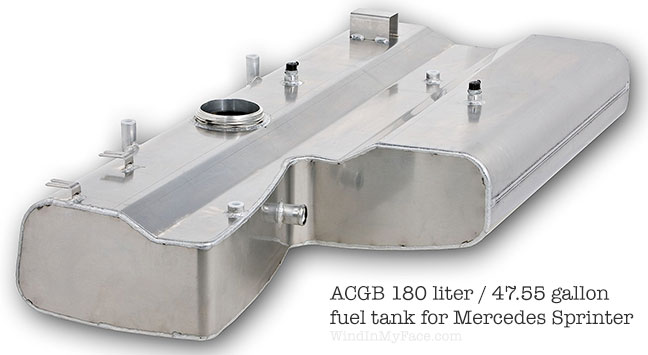
As delivered
Below, the high res version shows the welding quality (excellent) along with details like the six through-holes for mounting bolts. Mounting hardware is included but not show here. The is the top of the tank that sits against the underbody of the Sprinter.
On the bottom ground-facing part of the tank, the main concern is the polygonal protrusion about 9 X 9 inches and 1.5 inches deep. Should a rock catch the front of that welded-on panel, and rupture it, up to 47 gallons of diesel will pour out. I plan to protect the entire tank (or at least most of it) with a custom skid plate especially that protrusion.
Larger fuel tank details
Enter the ACGB replacement fuel tanks for Mercedes Sprinter; see the PDF for ACGB fuel tanks for Mercedes Sprinter.
The solution could not be more elegant: remove the original tank, put the larger tank in, utilizing the stock fuel tank and stock fuel pump and fill it up just as with the stock OEM 26.4 gallon tank.
- The Sprinter with 144-inch / 3.2 meter wheelbase accepts up to the 180 liter tank (47.55 gallons), which is 21 gallons and 80% more capacity than the stock 26.4 gallon tank.
- The Sprinter with 170-inch /3.6 meter wheelbase accepts up to the 220 liter tank (52.8 gallons), which doubles the capacity of the stock 26.4 gallon tank.
- There is a 140 liter / 37 gallon fuel tank, but it seems a bit pointless versus getting the largest tank unless perhaps the Van Compass skid plate for the stock OEM fuel tank can still be fitted (unknown).
- There is a drain plug at the rear of the tank.
The tank swap works just like the stock fuel tank, keeping the OEM fuel pump and connectors. As with the stock tank, the fuel gauge is not very accurate—I can burn off 2 gallons from full and the gauge doesn’t budget, and the Sprinter wants me to refuel with 6 gallons left. For an 80% larger tank, the low fuel warning will come at about 10 gallons remaining! But that’s not the fault of the tank; it’s a wildly inaccurate fuel gauge.
Eight-bay Thunderbolt 3 high-performance storage for photo and video.
Hard drives or SSDs.
Non-RAID or RAID-0/1/4/5/10.
Capacities up to 144 Terabytes!
Getting one
My contact for purchase within the USA is in the UK. Please tell Marc that Lloyd Chambers at WindInMyFace.com sent you. Regrettably, ACGB has no presence in the USA as of 2018, but that might change in late 2019.
Marc Stanford
Key Account Manager
ACGB +44 79 67 22 71 06
marc.stanford@acgb.co.uk
Installation and costs

Mercedes dealers should be able to install the tank in about 1.5 hours with experience according to ACGB, but I found this to be a woeful understimate given the poor instructions. Mercedes of Reno balked at first, but the service manager gave me the go-ahead and I had it installed there by their best Sprinter mechanic with 9 years of experience on Sprinters. Well, he now knows how to do it.
In the end, it took 4-5 hours due to unforeseen gotchas and low quality installation instructions. How ACGB can claim 1.5 hours to install is not very believable, since draining and removing the existing tank alone takes some time. Perhaps with repeated experience this is possible. But even simple details, like getting a few gallons of fuel to allow the van to drive for a fullup take a little time. So I don’t think that less than 3 hours total is realistic.
For USA Sprinter owners as of 2018, shipping and custom fees are a large part of the cost—as much as a bit more than half the cost of the tank itself! That is a serious cost, but until ACGB starts building tanks in the USA, those costs (air freight and customs) are unavoidable.
Rough costs to expect which all told are probably not good ROI for most users; consider it a convenience.
- Air freight: ~$550
- Customs and brokers fees: ~$300
- Cost of tank itself.
- Installation: $400 to $600, depending on shop. I recommend Mercedes of Reno since they now know how to install the tank.
Installation issues:
- A steel tab on the underbody has to be bent back to allow the tank to mount; the directions make no mention of this.
- The Mercedes dealer had no tool that would fit the large plastic cover to go over the large hole near tank center (see picture). Force was required, e.g., pounding it into place. Again, the instructions made no mention of this annoying setback, nor is the appropriate tool provided.
- Parts and bolts are not well described, so the mechanic had to study it all out basically from scratch.
- A bushing was missing from one of the through-bolt holes. The mechanic had to find and substitute something. My picture before install showed all the bushing, so somehow one of them fell out.
In use
The tank fills normally. Do not overfill the tank because just as with the regular tank, spillage through a relief valve can spread a smear of diesel on the tank. Parking on a hill can leave an air bubble at one end, so ideally park with the fill nozzle slightly uphill.
The most annoying thing is service stations that cut off at $75.00 or $100.00, because in California the diesel prices at $3.49 or so a gallon mean $140 or so for a 40 gallon fillup (assuming 7 gallons already in tank). So one has to run a credit card twice to get the tank full.
Because the tank is large, sloshing is readily audible when the tank is partly full. This is unavoidable.
The fuel gauge thinks it has the regular tank, but the Mercedes dealer is looking into a software feature that might exist to tell the system that there is a larger tank. Basically, double the amount it shows, e.g., a range of 480 miles should be taken as a range of 960 miles. As with the stock tank, the fuel gauge is only accurate once a few gallons are burned off (2-3 with the stock tank, 4-6 gallons with the large tank). Once below the 7/8 mark, I found I could predict the fillage required to within 1 gallon e.g., I would predict (using a calculator and the fuel gauge) 29.6 gallons and actual would be 30.1 gallons.
The fuel level sensor in my install turned out to be flaky. For example, reading 5/8 full I filled it completely. Driving away, it still read 5/8 full and stayed that way for 50 miles and overnight. The next morning, it read full. Something may be sticky or not quite right with the fuel gauge; I’ll have that checked out the next visit.
Overall, I am very happy with the new fuel tank. What’s funny is that when the fuel gauge reads 5/8 full, that’s about 31 gallons of diesel left—about 3 gallons more than the entire capacity of the stock tank. This takes some adjustment in refueling patterns—far less frequent—and in thinking about range and such—I drove from Reno to home, idled two hours, then drove to San Fernando and still had about 12 gallons of fuel left with the gauge reading more than 3/8 full.
Gas Buddy
Wanting the lowest cost refueling, I tried Gas Buddy on several occassions. Regrettably, it servers up misleading or just plain wrong data, including quoting a diesel price at a Costco which didn’t even sell diesel. So I developed the habit of watching every displayed diesel price as I passed by stations, just to know the going rate.
Field trip of 3400 miles
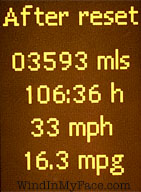
This trip is on top of 2000 miles prior.
The tank performed flawlessly, but there is one caveat which is true of both the stock tank and the ACGB tank: do not overfill up into the fuel filler pipe; I did so a few times and this will leak fuel (by design), which at first made me think I had a leak. After stopping this overfilling, no more leakage.
The fuel gauge can be quite accurate, but it can also be off by up to 5 gallons. Since the stock fuel gauge had similar issues, I tend to pay more attention to miles driven. Also, I have seen the gauge stick: reading 11/16 full, fill the tank, no change for about a day—possibly a stuck float. This always resolved itself after a day or so, and most of the time does not happen. It seems to happen more at high altitude.
That the Sprinter has inaccurate gauges is shown by another fact: adding a gallon of BluDEF took 150 miles for the BluDEF gauge to properly reflect that fill-state.
See also Mercedes Sprinter Maintenance: Fuel Economy (Miles Per Gallon / MPG).
Eight-bay Thunderbolt 3 high-performance storage for photo and video.
Hard drives or SSDs.
Non-RAID or RAID-0/1/4/5/10.
Capacities up to 144 Terabytes!
Gallery
Pictures of tank details and the final install.
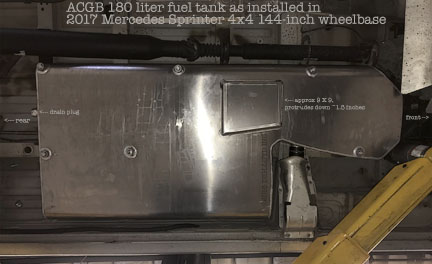
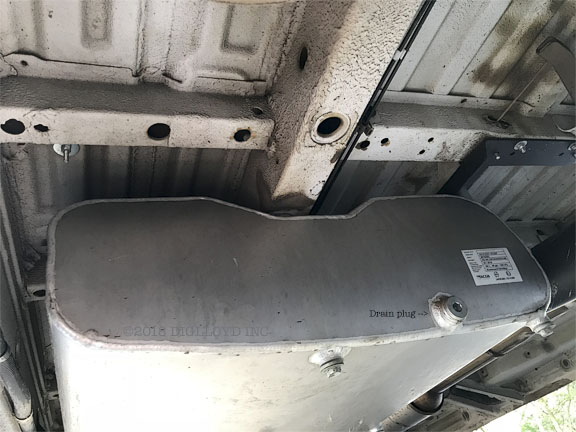
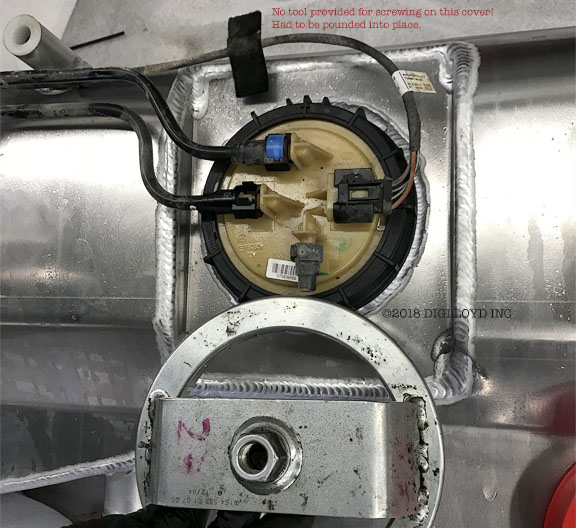
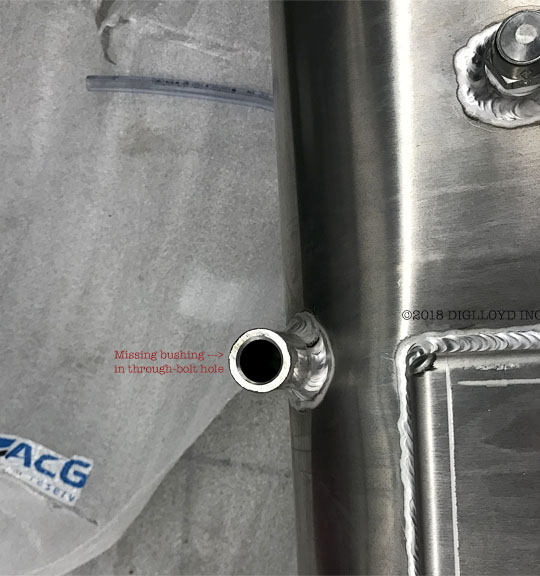
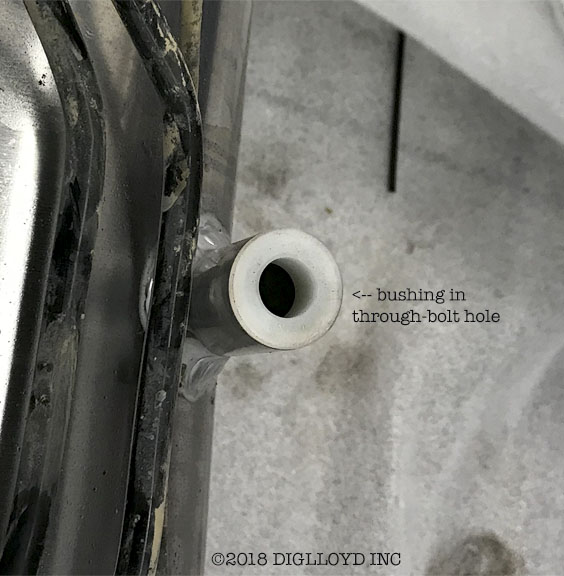
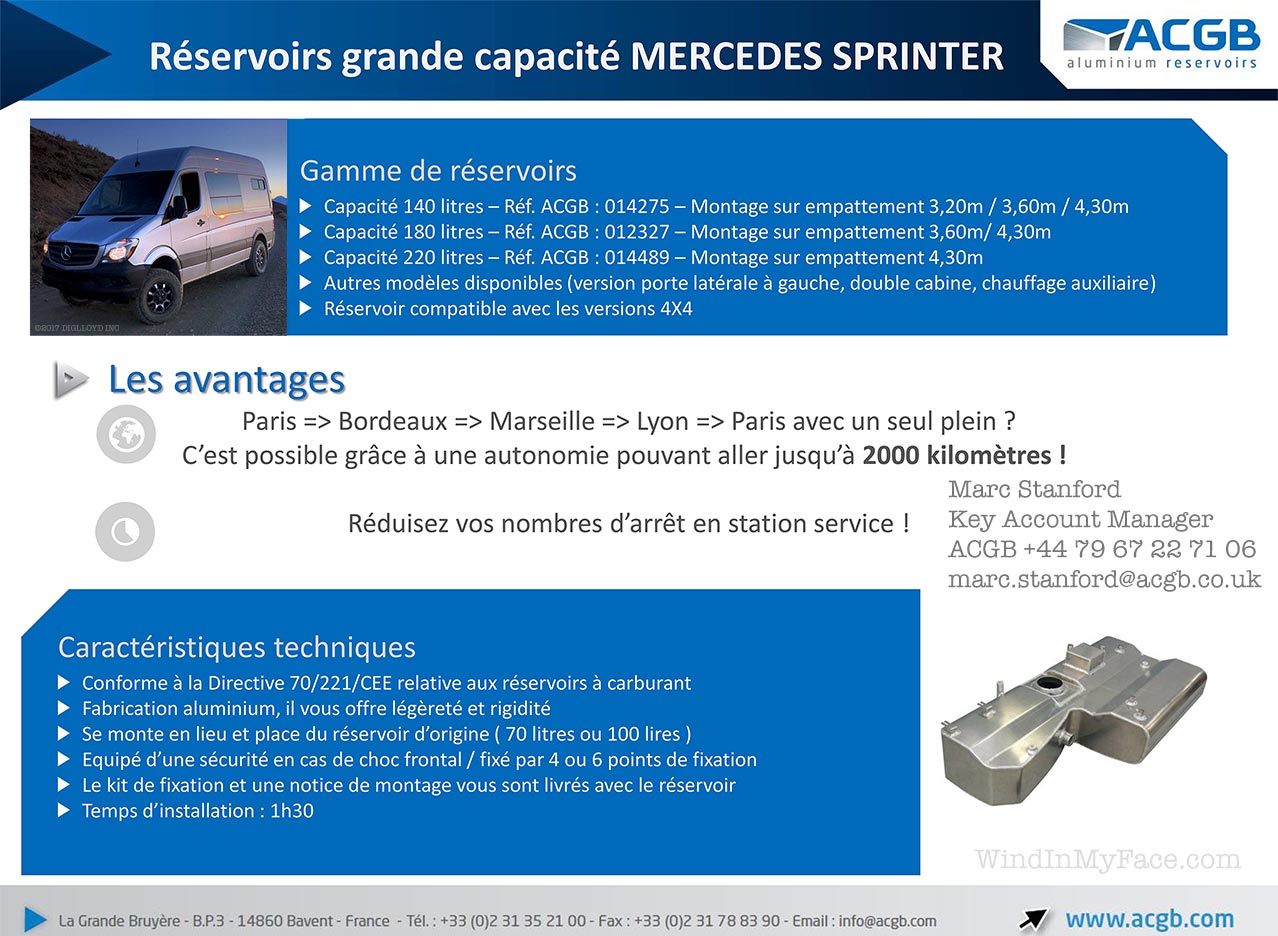
Seagate 22TB IronWolf Pro 7200 rpm SATA III 3.5" Internal NAS HDD (CMR)
SAVE $100



